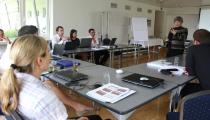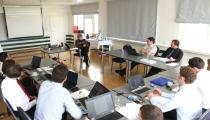What is Risk?
Everyone who is facing a job that requires important decisions is dealing with risks and uncertainties. Many famous examples over the last years have shown us what insufficient preparation for risks can cause. As always the ZEBS tries to go one step ahead and sensitize its students to this topic in their daily affairs.
At the Insurance and Risk Management ZEBS MBA course Prof. Dr. Nielson from the University of Calgary, gave us, to begin with, a grip of what risk really is. Some of us had to reassess our points of view on the idea of risk. She explained the notion of risk and the different kinds of risks managers can face in daily business and also in extraordinary situations. The first part of this day was concluded with a chapter about the importance of risk management.
The afternoon was spent on finding out the importance of correlation for risk management and conventional approaches used to manage risks.
We were happy to close the day with watching the quarter-finals game Germany vs. Greece at the European soccer championship.
On Saturday morning we returned with full motivation into the second day which began with the general tools that are available for managing risk. We got to know the internal and external concepts of risk handling. We took a closer look at external handling, which means pooling the risks with other companies which is the general idea of insurances. Finally we were taught the advantages and disadvantages of the different concepts and indicators we could use to decide how to handle risks.
The afternoon was focused on the matter of risk communication. We were enlightened on the different aspects that have to be considered when you are taking part in a risk management team or project. An especially useful matter was the different perception of communication if you are talking about risk to Joe Public. After a little break – with excellent chocolate cake – we went deeper into the communication – changing the focus from risk to crisis communication.
On Sunday morning we focused on examples of good risk management and bad risk management. As so often this weekend, a British petroleum company displayed to us the effect of an insufficient risk management. On the other hand Iceland showed how to manage a crisis like the eruption of the Eyjafjallajökull in 2010, which threatened the whole economic system.
After the lunch break on Sunday we were grouped by the business sector we were working in and we had the task to think about the risks that we are encountering in our key industries and how these risks are or could be managed. Every group had to present its results and we had some lively discussion about risks in our special branches.
During the whole weekend all of us had to hold a brief presentation about a risk related topic we had chosen in advance of the course. A broad range of topics were covered from risks that are connected to Carbon Sequestration, classical portfolio risk management and even more abstract topics such as reputation risk management.
Despite the time intensity we were able to cover a lot of important aspects of risk management and gained important impulses for our daily business.
Christoph, IMP student







